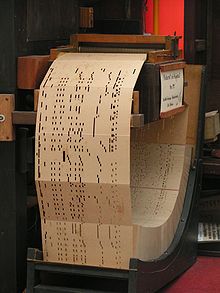Fair organ
The fair organ , also known as the fair or carousel organ, belongs to the genre of mechanical musical instruments and is closely related to the barrel organ or the fixed orchestrion .
The fairground organ has mobility in common with the barrel organ, although the latter - because it is much larger and heavier - usually needs its own transport trailer for cars or even trucks. The similarity to the orchestrion is that in addition to the most varied of organ pipes , rhythm instruments also help to shape the music. All functions (musical notes, register switching , rhythm impulses, movements of figures) are controlled by the program carrier.
With the help of the fair organ, showmen tried to make their amusement establishments more attractive for the public since the second half of the 19th century. For example, carousels, ship swings, riding schools and the Panoptikum (walk-in swing tent) wooed the audience with musical performances.
The fairground organ ostensibly wants to imitate a small orchestra. However, the arrangement of the music and the combination of the timbres usually create an incomparable, completely independent listening experience. When selecting the music, preference was often given to marches and dance music. But also cross-cuts from popular operas and operettas as well as hit songs and so-called character pieces (“Die Post im Walde”; “Heinzelmännchens Wachtparade”) are part of the repertoire .
In the beginning, fair organs were driven with weight drives or cranks, occasionally also with steam engines or gas engines. Later (after around 1920) they were mostly equipped with an electric motor .
The music of the first fair organ was programmed on pin rollers . From 1892, the company Gavioli & Cie , Paris , first built a new type of valve control in which the music information was punched into cardboard boxes (see below). This new system was quickly adopted and varied by other manufacturers. At the beginning of the 20th century - especially by the organ builders in Waldkirch - the folding cardboard note (see picture) was replaced by lighter piano rolls , which are gently scanned by compressed or suction air. Both systems - cardboard notes and perforated tape - are still used today in mechanical musical instruments.
Folding cardboard notes - also known as books - are small-format sheets of lacquer-soaked cardboard, connected with strips of linen, which are stored folded as a fanfold . The music and control information for the instruments are punched into the boxes as round or elongated holes . Note perforated tapes are usually made of simple paper, more recently also made of plastic film. The production of folding boxes and perforated tape rolls requires musical skill, paired with a feeling for the peculiarities of the respective musical instrument. Some great arrangers could be found in the workshops of the companies Gavioli and Limonaire Fréres ( Paris ) or Bruder, Ruth or Frei ( Waldkirch ). Even today there are still some excellent arrangers for modern pieces of music that can be heard on the old original instruments or new structures.
The above-mentioned organ building companies were the most important manufacturers of fairground organs until the 1930s. In addition, there were some important Belgian manufacturers such as Decap and Mortier ( Antwerp ) and producers in the Netherlands.
With the introduction of electrical amplifier technology and the electrical record player at the end of the 1920s , the production of fairground organs ebbed more and more until the beginning of the Second World War . The now cheaper and simpler "electrical recording" of music by the carbon microphone and the reproduction by amplifiers over loudspeakers meant that the complex organ works were no longer competitive. They were often drowned out and also felt to be out of fashion. Only a few small handicraft businesses were still able to maintain and repair old fair organs after the war. New buildings with the old control technology were a rarity. The Rhine-Hessian organ builder Franz Göckel was an exception.
Many valuable instruments fell victim to the ax between 1930 and the mid-1960s and were literally burned. At best, they were left in warehouses and left to their own devices.
Nevertheless, many families of showmen cherished their organs. It is still the custom in fairground circles to honor a deceased family member on their last journey with a piece of music played by their own organ.
At the end of the 1960s there was a return to the old, romantic fair organs. The wave of nostalgia hit the world and brought these instruments to ancient times. Restored organs can now be found in the associated splendid carousels, play at Christmas markets or can be admired and heard in their own museums.
literature
- Herbert Jüttemann: Waldkirch rotary and fairground organs. History, structure and manufacturing programs . 2nd Edition. Kaufmann, Lahr 2005, ISBN 3-7806-7237-5
- Gavioli & Cie product catalog, around 1903 (no place, no year)
Web links
- Dance organs in the Auto & Technik Museum Sinsheim
- Sound machine museum in Dürnten ZH, Switzerland


